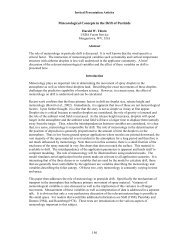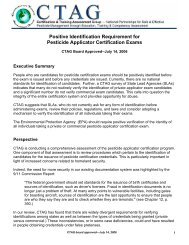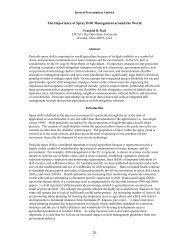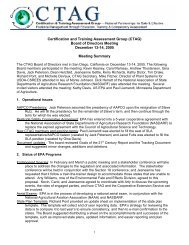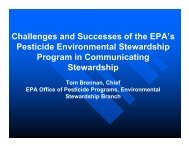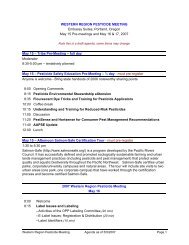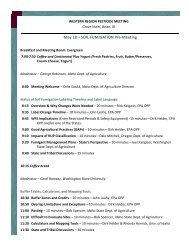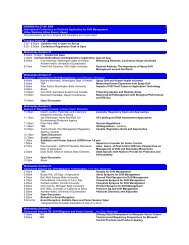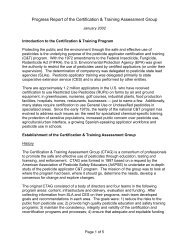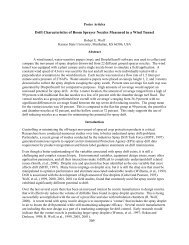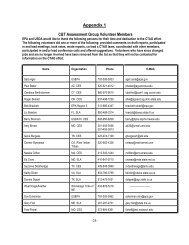2004 March Board Meeting Summary - WSU Pesticide Safety ...
2004 March Board Meeting Summary - WSU Pesticide Safety ...
2004 March Board Meeting Summary - WSU Pesticide Safety ...
You also want an ePaper? Increase the reach of your titles
YUMPU automatically turns print PDFs into web optimized ePapers that Google loves.
CTAG <strong>Board</strong> of Directors <strong>Meeting</strong><strong>March</strong> 10 - 11, <strong>2004</strong>The CTAG board of directors met in Arlington, VA on <strong>March</strong> 10 and 11, <strong>2004</strong>. Thefollowing CTAG board of directors members participated in the meeting: Kevin Keaney,CTAG co-chair; Gina Davis, CTAG co-chair; Carol Ramsay, CTAG vice chair; RichardPont; Jeaneanne Gettle; Monte Johnson; Jack Peterson; Win Hock; and Al Muench,CTAG secretary.Four members were not present: Carl Martin, Bill Tozer, Elaine Wilson, and, PatO’Connor-Marer.More information about each board member is at http://pep.wsu.edu/ctag/board.html1. CTAG Operational IssuesAAPCO UpdateOn <strong>March</strong> 7, <strong>2004</strong>, Gina Davis and Jack Peterson gave a detailed CTAG update to theAAPCO board of directors. (A copy of the update is on the CTAG web siteathttp://pep.wsu.edu/ctag/pdf/AAPCO_04.pdf).CTAG CharterSeveral amendments to the CTAG charter were approved. The revised charter isavailable on the CTAG web site athttp://pep.wsu.edu/ctag/<strong>Board</strong> Member Departures and ArrivalsMary Ellen Setting, Maryland Department of Agriculture; Elaine Wilson, TPPC liaison,and Jeanne Heying resigned their positions. Pat O’Connor-Marer completed his term.Kathy Dictor, and Andrew Thostenson started their terms at the close of the meeting.Dean Herzfeld joined the <strong>Board</strong> in June <strong>2004</strong>. Lori McKinnon is the new TPPCliaison.Win Hock and Bill Tozer will complete their terms on <strong>March</strong> 31, 2005.2. C&T Plan Template – Current Status of ProjectEPA is investigating moving the template to an EPA server. No modifications will occuruntil the move is finalized. Current grant guidance makes use of the template voluntaryin FY <strong>2004</strong>. In FY 2005, SLAs will be expected to use the template. EPA will ask theregions to pilot at least one state using the template in each region.3. CTAG Issue Papers – Status and Next StepsThe board previously approved the following issue papers and authorized submission ofthe issue papers to SFIREG. These issue papers were also presented and discussed atPage 1 of 4
the 2003 North American <strong>Pesticide</strong> Applicator Certification and <strong>Safety</strong> EducationWorkshop:50/50 MatchThis issue paper proposes a change in FIFRA to replace the 50/50 C&T cooperativeagreement match requirement with the traditional 85/15 match used in other FIFRAprograms. Approved and received outside support.Requiring Monitored, Written, Closed-Book ExamsThis issue paper seeks to improve the competency of certified applicators by requiringall states to use monitored, written, closed-book examinations for certification of privateand commercial pesticide applicators. Approved and received outside support.Positive Identification for Restricted Use <strong>Pesticide</strong> (RUP) PurchasesThis issue paper recommends that EPA develop guidelines and implementrequirements for positive identification of all private and commercial applicators makingface-to-face purchases of restricted use pesticides. This issue paper is designed toimprove the level of security surrounding the purchase of RUPs by requiring positiveidentification in addition to the possession and presentation of a valid pesticideapplicator certification credential. (This issue paper does not address telephone andInternet sales of RUPs.) Approved and received outside support.Minimum Age Requirement for CertificationThis issue paper recommends that EPA implement a minimum age requirement forcertification as a requirement for approval of C&T plans. The issue paper was rewritten,in response to comments received at the 2003 North American <strong>Pesticide</strong> ApplicatorCertification and <strong>Safety</strong> Education Workshop, to recommend 18 years as the minimumage for commercial applicators and 17 years as the minimum age for privateapplicators, unless states can verify that a 16 year old private applicator would not haveaccess to agricultural chemicals classified as category 1 products. Once redrafted,CTAG will request comments.4. Workgroup #2 - <strong>Pesticide</strong> <strong>Safety</strong>WPS IntegrationThe draft issues concerning integrating handler training into the certification programwere presented to EPA staff who will develop a paper to guage EPA managementsupport for the concept before taking the proposals further.Exam Administration & Security Procedures ManualThe board agreed that this is a very positive CTAG piece. EPA will use the printingcontractor now working on the national core manual to help with formatting and printingthis manual. Use of this manual will be linked to the use of the new national core examso that EPA can have some assurance that states using the core exam have in placeadequate exam security procedures to help protect EPA’s investment in the core exam.Exam BlueprintsA draft issue paper was proposed to address the burden that each state faces inPage 2 of 4
developing its own examination and training system for pesticide applicator categoryexams. An exam blueprint is an important tool that SLAs can use to develop the examthat they determine best meets their specific needs. CES can use the blueprint todevelop companion training materials.It was suggested that job analyses for the Aerial category and the Right-of-Waycategory might be good beginning points for this exercise. An appropriate work groupwill be established for this effort.Subgroup to Improve Trainer SkillsThere was a discussion of the status of work by this subgroup. It was mentioned thatMexican pesticide officials would like help in developing a C&T program. EPA willpropose this as a NAFTA project and will draw on the work of this subgroup.5. Workgroup #3 on Tiered ClassificationThe Tiered Classification Workgroup completed their charge. The workgroup proposeda tiered system of classifying pesticides that would establish education and trainingrequirements covering all occupational users of pesticides. A tiered classificationsystem will be a critical element in CTAG’s plan for the restructuring of the currentcertification and training program into a comprehensive pesticide worker safety programthat covers all types of pesticide users, and incorporates appropriate education, trainingand examination components to reduce risks to pesticide applicators, other people andthe environment.The papers were presented to EPA staff who will develop a concept paper for EPAmanagement before taking the proposal further.6. Workgroup #4 – PSEP Long-term FundingCTAG committed, in August 2003, to establishing a new workgroup to develop aprocess for distributing <strong>Pesticide</strong> <strong>Safety</strong> Education Program (PSEP) funds. However,since EPA and USDA announced that they and external stakeholders will conduct anational program review, part of which will focus on funding, the focus for this proposedworkgroup will be revised depending on the scope and findings of the national programreview.7. Fumigation Management PlansEPA inquired about the status of work by the Oklahoma State extension service (JimCriswell) on a phosphine fumigation manual which would addresses the new labelrequirements. The long overdue manual is expected to be available in June, <strong>2004</strong>. Newlabels are now on the Degesch America web site.Updated manuals and sample fumigation management plans will be needed by bothprivate and commercial applicators.Page 3 of 4
8. <strong>Pesticide</strong> Registration Improvement Act of 2003EPA distributed information on the <strong>Pesticide</strong> Registration Improvement Act of 2003(PRIA.) The PRIA will provide no less than $750,000 and no more than $1,000,000 peryear, for five years, to “enhance current scientific and regulatory activities related toworker protection.” In addition to contract and grant money, EPA will get new staffpositions as a result of PRIA.9. The Evolution of a CTAG IssueA draft of “CTAG Process for Issue Papers” was discussed. This paper details andstandardizes the steps in the development of CTAG issue papers. The draft wasapproved by the board, posted on the CTAG web site and sent to the AAPCO, AAPSE,ASPCRO, PSEP and TPPC listserves for review and comment. The final paper will beadopted at the August <strong>2004</strong> CTAG board meeting.A standard format will be developed for CTAG issue papers. The board secretary willmaintain a progress tracking system for CTAG issues and activities.10. CTAG and Regional <strong>Meeting</strong>sEach of the regional PSEP/C&T meetings this year will devote from one to two hours fordiscussion of CTAG issues and to receive feedback from participants. A standard slideset will be developed so that consistent presentations are given at each meeting. Theslide set will include the CTAG process for issue papers as well as current workgroupactivities.11. CTAG Outreach – Building More Support Among Our PeersThe board’s discussion led to agreement to take the following steps to improve CTAGcommunications with partners and stakeholders:• Post all upcoming scheduled CTAG meetings on the web site.• Post minutes, or a summary, of all CTAG meetings on the web site.• Post all CTAG issue papers and other documents on the web site, and requestcomments within a specific time period.• Notify AAPCO, ASPCRO, AAPSE, PSEP and TPPC listserves of scheduledmeetings, minutes, issue papers or other relevant documents and, whenappropriate, request comments within a specific time period.• Request comments and suggestions from AAPCO, ASPCRO, AAPSE, PSEP andTPPC on relevant issues or topics that should be considered by CTAG.12. CTAG August <strong>2004</strong> <strong>Board</strong> of Directors <strong>Meeting</strong>The board agreed to meet in Madison, WI, on August 3, from 1:00 p.m. - 5:00 p.m., andon August 4, from 8:00 a.m. - 5:00 p.m. The co-chairs will solicit agenda items andprepare the agenda for the meeting. One suggested agenda topic is a report from EPAon the status of global harmonization.Page 4 of 4



